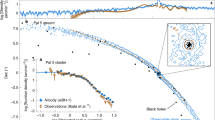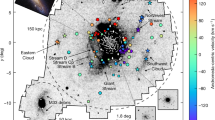Abstract
RECENT high-resolution optical observations1,2 show that the nucleus of the nearby spiral galaxy M33 has a small core radius and an unusually low velocity dispersion. These parameters yield a central dynamical timescale of only a few tens of millions of years, suggesting that the nucleus of M33 has undergone core collapse, as is believed to occur in globular clusters. Here we propose a model for the post-collapse core of M33. By analogy with globular clusters, the formation of tight binary systems powers the re-expansion of the core, and we expect in particular that low-mass X-ray binaries form with a rate about equal to that of all galactic globular clusters combined. About a dozen such binaries should be present, and their combined emission may explain the large (1039 erg s-1) and enigmatic unresolved X-ray emission from the nucleus of M33. In addition, tidal formation of cataclysmic binaries may lead to a nova rate of ≳ 1 per century. Numerous blue stragglers have probably formed through mergers caused by stellar collisions, but their density is probably too low to explain the blue colour of the nucleus. Young stars are the likely cause for the colour, and their presence may complicate the simple dynamical picture presented here.
This is a preview of subscription content, access via your institution
Access options
Subscribe to this journal
Receive 51 print issues and online access
$199.00 per year
only $3.90 per issue
Buy this article
- Purchase on Springer Link
- Instant access to full article PDF
Prices may be subject to local taxes which are calculated during checkout
Similar content being viewed by others
References
Kormendy, J. Pap. presented at 1990 Aspen Workshop on Stellar Dynamics and Galaxy Formation (1990).
Kormendy, J. & McClure, R. D. Astrophys. J. (submitted).
Lauer, T. R. Astrophys. J. 292, 104–121 (1985).
Kormendy, J. Astrophys. J. 295, 73–79 (1985).
Kormendy, J. in Nearly Normal Galaxies: From the Planck Time to the Present (ed. Faber, S. M.) 163–174 (Springer, New York, 1987).
Tonry, J. L. Astrophys. J. 322, 632–642 (1987).
Dressler, A. & Richstone, D. O. Astrophys. J. 324, 701–713 (1988).
Kormendy, J. Astrophys. J. 325, 128–141 (1988).
Kormendy, J. Astrophys. J. 335, 40–56 (1988).
Kormendy, J. & Richstone, D. Astrophys. J. (submitted).
Lauer, T. R. et al. Astrophys. J. 369, L41–44 (1991).
Binney, J. & Tremaine, S. Galactic Dynamics (Princeton University Press, 1987).
Spitzer, L. Dynamical Evolution of Globular Clusters (Princeton University Press, 1987).
Murphy, B., Cohn, H. & Hut, P. Mon. Not. R. astr. Soc. 245, 335–349 (1990).
Goodman, J. & Hut, P. Nature 339, 40–42 (1989).
McMillan, S., Hut, P. & Makino, J. Astrophys. J. 362, 522–537 (1990), 372, 111–124 (1991).
Gao, B., Goodman, J., Cohn, H. & Murphy, B. Astrophys. J. 370, 567–582 (1991).
Lauer, T. R. et al. Astrophys. J. 369, L45–49 (1991).
Fabian, A. C., Pringle, J. E. & Rees, M. J. Mon. Not. R. astr. Soc. 172, 15–18P (1975).
Lee, H. M. & Ostriker, J. P. Astrophys. J. 310, 176–188 (1986).
Verbunt, F. & Hut, P. in IAU Symp. 125, The Origin and Evolution of Neutron Stars (eds Helfand, D. J. & Huang, J. H.) 187–197 (Reidel, Dordrecht, 1987).
Long, K. S., D'Odorico, S., Charles, P. A. & Dopita, M. A. Astrophys. J. 246, L61–64 (1981).
Markert, T. H. & Rallis, A. D. Astrophys. J. 275, 571–577 (1983).
Peres, G., Reale, F., Collura, A. & Fabbiano, G. Astrophys. J. 336, 140–151 (1989).
Gottwald, M., Pietsch, W. & Hasinger, G. Astr. Astrophys. 175, 45–49 (1987).
Verbunt, F., van Paradijs, J. & Elson, R. Mon. Not. R. astr. Soc. 210, 899–914 (1984).
Helfand, D. Publ. astr. Soc. Pacific 96, 913–931 (1984).
Lewin, P. C. & Joss, W. H. G. Space Sci. Rev. 28, 3–87 (1981).
Manchester, R. N. et al. Nature 352, 219–221 (1991).
Hut, P. & Verbunt, F. Nature 301, 587–589 (1983).
Gallagher, J. S., Goad, J. W. & Mould, J. Astrophys. J. 263, 101–107 (1982).
Nieto, J.-L. & Auriere, M. Astr. Astrophys. 108, 334–338 (1982).
O'Connell, R. W. Astrophys. J. 267, 80–92 (1983).
van den Bergh, S. Publ. astr. Soc. Pacific 103 (in the press).
Author information
Authors and Affiliations
Rights and permissions
About this article
Cite this article
Hernquist, L., Hut, P. & Kormendy, J. A post-core-collapse model for the nucleus of M33. Nature 354, 376–377 (1991). https://doi.org/10.1038/354376a0
Received:
Accepted:
Issue Date:
DOI: https://doi.org/10.1038/354376a0
Comments
By submitting a comment you agree to abide by our Terms and Community Guidelines. If you find something abusive or that does not comply with our terms or guidelines please flag it as inappropriate.



